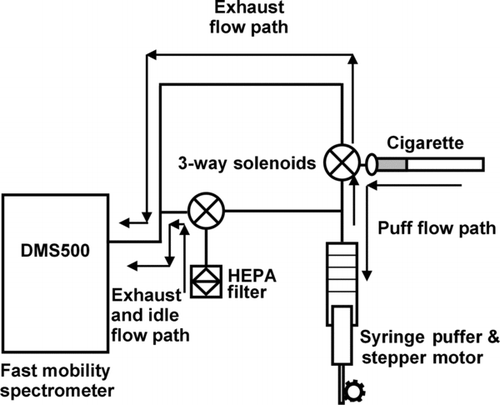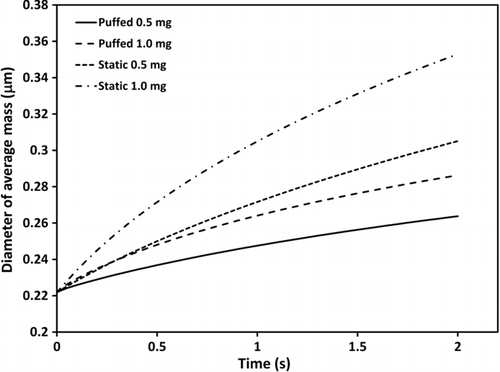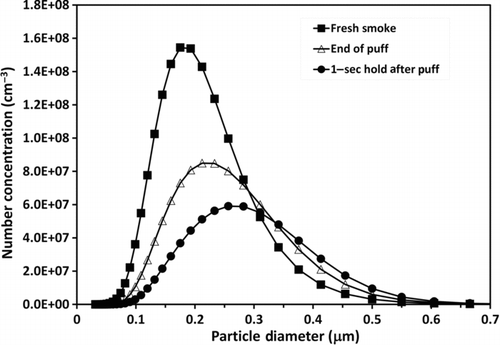Abstract
The effect of Brownian coagulation on the particle size distribution of mainstream cigarette smoke subjected to conditions encountered in the mouth during human smoking has been examined experimentally and simulated with a numerical coagulation model. Smoke puffed into an artificial mouth was subjected to variable aging times and exhausted to a fast electrical mobility analyzer for particle size distribution measurement. The experimental results agreed well with the predictions of a sectional-based model of Brownian coagulation that allowed for the modeling of various continuous feed and fixed volume coagulation environments. Due to the steady input of fresh, smaller particles, particle growth during the filling of the mouth with smoke, a process intrinsic to the puffing maneuver, was significant but slower than that during fixed volume, static aging. Mouth hold times and initial smoke mass concentration were found to be strong determinants of the average particle size of smoke exiting the mouth into the respiratory tract during inhalation. The results also suggest that the smallest particles present in fresh smoke, those less than 0.1 μm diameter, are greatly reduced in number during the unavoidable mouth coagulation during puffing and virtually eliminated after 1 s of mouth hold.
1. INTRODUCTION
The particle size distribution of mainstream cigarette smoke is a key physical parameter influencing the deposition of smoke components in the respiratory tract during smoking (Robinson and Yu Citation2001; Baker and Dixon Citation2006). Most of the reported studies of mainstream smoke particle size have focused on the measurement of fresh, minimally aged smoke as it exits the cigarette (Bernstein Citation2004; Baker and Dixon Citation2006). Although appropriate for the analysis of aerosol dynamics in the cigarette, the particle size of fresh smoke is not the best starting point for the assessment of respiratory tract deposition during smoking unless changes in smoke properties taking place in the mouth are accounted for in the analysis.
It can be argued that hygroscopic particle growth in the mouth will be limited and transitory and can be neglected for the objective of characterizing smoke particle size as it exits the mouth and enters the conducting airways during inhalation. Transport of water vapor through the bulk of the aerosol in the mouth will be inhibited in the relatively low surface area to volume ratio oral cavity by the very high particle number concentrations in mainstream smoke. This effect of high number concentration is analogous to the observed inhibition of nicotine vapor transport in the much higher surface area to volume airways of the respiratory tract (Ingebrethsen Citation2006). Additionally, reduced and transitory relative humidity levels are expected to be produced as smoke in the mouth is flushed and mixed with inhaled ambient air during inhalation thereby reducing or reversing hygroscopic growth prior to the smoke entering the airways.
Coagulation thus becomes the primary process for particle growth prior to inhalation. Particle growth by coagulation, as dense mainstream smoke ages in the mouth, can result in significant differences between the size distributions of fresh smoke and that which enters the airways during inhalation. If such differences are overlooked, or if inappropriately simplified coagulation estimates are employed, erroneous interpretations of experimental measurements and/or inaccurate predictions from theoretical deposition models can result.
The “taking” of a puff from a cigarette is, fundamentally, a two-step process involving time-segregated puffing and inhalation maneuvers. The current study focuses on coagulation taking place during the puffing part of the process and recognizes that the “puffing” step itself can be composed of three stages, each of which produces a differing coagulation environment. The first and most complex stage is the drawing of smoke from the cigarette into the mouth. During this first stage, fresh smoke continuously feeds into the expanding oral cavity and mixes with rapidly coagulating smoke from earlier in the puff. The effect on the coagulation process of this steady source of fresh particles being injected into the aging mixture, all at high number concentration, will be shown to be quite significant. Specifically, this complex mixing process will result in a particle size distribution in the mouth at the end of the puff that is significantly different both from the fresh smoke distribution and from that which would be calculated from the simple aging of a closed, fixed volume of fresh smoke without the continuous feed of fresh particles.
After the filling of the mouth with smoke, there is the possibility of a second, distinct holding period during which a fixed volume of smoke statically ages and coagulates. Finally, during inhalation, inhaled air mixes with smoke as the oral cavity is flushed. Coagulation then proceeds at a reduced rate as the smoke is diluted and exits the mouth into the respiratory tract. The current study attempts to elucidate the changes in particle size distribution resulting from coagulation during each of these three differing sets of conditions in the mouth during smoking.
The approach taken in the current study was to measure the growth rates of mainstream smoke in controlled experiments that mimic the smoking process and to compare the measurements with the predictions of theoretical simulations. The theoretical model was then used to make additional predictions of particle size and number concentration for conditions not directly probed by experiments. The goal of the study was to provide a more accurate description of mainstream smoke properties in the mouth during smoking and the various influences that determine those properties.
2. METHODS
2.1. Numerical Simulation of Coagulation
A computer code to simulate a coagulating aerosol was constructed following the sectional representation approach of Gelbard et al. (Citation1979) and Gelbard and Seinfeld (Citation1980). The aerosol is represented by size-bin populations, and the rates of transfer of particles among bins are calculated by integrating the appropriate coagulation equations across bin sizes and between bins. The procedure converts a system of integro-differential equations into a system of ordinary differential equations that are easily solved using a standard differential equation solver. This approach does not require an assumed form for the particle size distribution, allows for arbitrary assignment of initial concentrations, and does not constrain the form of the predicted size distributions. No measurements of possible particle charge distributions were available for the cigarettes and conditions of the current experiments, and only Brownian coagulation without any influence of possible charge effects was included in the analysis (Robinson and Yu Citation1999).
In addition to the coagulation terms, the differential equations also included inlet and outlet terms for each bin that can be used to represent a feed of aerosol or particle-free dilution gas into the coagulating aerosol volume and a volumetric exhaust from the aerosol. The net result was a model capable of simulating several mainstream smoke conditions of interest. With options set for an inlet flow containing particles and a zero exhaust flow, the conditions in the expanding oral cavity during puffing of a cigarette are simulated. Aging of a fixed volume of smoke in the oral cavity after puffing but before inhalation is represented by setting the source flow to zero. Finally, coagulation during the dilution and flushing of the oral cavity with inhaled air is represented with a nonzero source flow of particle-free gas. Initial oral cavity volume was taken to be 1 mL consistent with prepuff mouth volume being minimized by the movement of the tongue toward the lips and collapse of the cheeks. After-hold flushing was taken to occur with a mouth volume equal to the final puff volume, usually 60 mL. It is possible that less than complete mixing takes place during flushing after mouth hold that would result in higher flushed number concentrations than those calculated for complete mixing and also result in larger growth from coagulation. This scenario is not explicitly modeled in the current study, but the degree of such an effect can be estimated by comparing the effects of increased mouth hold times in the calculations presented here.
The model used 45 bins spaced by a ratio of 1.1, yielding a diameter range of 0.030–2.19 μm. With this size range and the initial size distributions determined for mainstream smoke, no growth of particles above the largest size boundary was observed for any aging time. Mass was strictly conserved in the simulations. The computer code was written in MATLAB and, after calculation and storage of the interbin transfer coefficients, simulations could be performed in seconds on a desktop computer. The accuracy of the coagulation calculations was confirmed by successful reproduction of monodispersed coagulation rates, the trends in coagulation rate with polydispersity predicted by Lee and Chen (Citation1984), and the convergence of geometric standard deviation (GSD) to a value of approximately 1.4 for a range of size distributions independent of initial GSD value.
Theoretical estimates of particle surface losses by diffusion suggest that for smoke aging in the mouth, diffusional loses are minimal for the smallest particles of interest and much smaller than for the loss of these particles by coagulation. For a 60 mL sphere filled with stagnant cigarette smoke, Fick's law predicts the deposition loss of 0.05 micron diameter spheres to surfaces by diffusion to be approximately 0.68% over 1.0 s, while this size particle is reduced in number concentration 85% by coagulation over the same time. Diffusional loss rates would decrease for larger particles. Deposition from settling for the stagnant smoke in the sphere at the conditions just described is predicted to be less than 0.2% for 0.5 micron particles over 5 s. Significant increases in these estimates due to the relatively gentle flow and mixing in the mouth during puffing seem unlikely as inertial effects on the size particles observed and enhancement of deposition from mixing are expected to be small. Hence we believe that an accurate assessment of the effects of mouth filling and ageing during smoking on the size distribution of smoke can be made under the assumption that surface loses contribute minimally to the net changes taking place in the smoke.
2.2. Size Distribution Measurements of Aging Cigarette Smoke
Particle size distributions of fresh and aged mainstream cigarette smoke were obtained using an automated puffing/aging device and a fast electrical mobility particle size analyzer. Smoke was drawn from a cigarette into a syringe by a computer controlled plunger, held for specified aging times, and then exhausted at controlled rates into the inlet flow of the mobility analyzer. The arrangement allowed for controlled aging and measurement of samples from a single puff aged over zero to several seconds. The mobility analyzer measured the size distributions of the exhausted smoke samples that were received as resolvable pulses of aerosol in the sample flow stream.
The experimental apparatus is shown schematically in . A pair of computer-activated solenoid valves was used to control and coordinate the flows from the cigarette, the exhaust from the syringe, and the inlet flow to the analyzer during the experiments. The switching arrangement allowed the puff to be taken into the syringe while a steady flow into the mobility analyzer was maintained. After the puff, the valves were switched to allow the smoke samples exhausted from the syringe to be fed into the mobility analyzer inlet flow. When the valves switched after the puff, a sample of fresh, unaged smoke was immediately swept into the sampling stream giving a measure of the fresh smoke size for that puff. Separate experiments were performed that showed no difference between fresh smoke sampled from the midpoint of the puff and that sampled at the end of the puff, the latter being the standard sampling mode for most experiments. Five subsequent samples of a fifth of the full puff volume each were exhausted at 1-, 3-, 5-, 7-, and 9-s aging time after the puff. The cigarettes were smoked with square-wave puff profiles of either 60 or 35 mL volume, 2-s duration, and 30-s puff intervals. Three types of commercial cigarettes, primarily differing in their level of nominal filter ventilation (filter lengths and cigarette circumferences were all approximately equal), were used in these studies in order to provide fresh, unaged smoke across a range of particle number concentrations. Filter ventilation level is the percent of a steady 17.5 mL/s flow out the mouth end of an unlit cigarette that enters the cigarette through the filter perforations. Ventilation level is useful as a ranking index for smoke dilution, but does not predict the actual dilution level of smoke during the puffing of lit cigarettes due to variable flow resistances and other factors. For convenience, these commercial products will be labeled as high, medium, and low ventilation cigarettes (ventilation levels of 54%, 30%, and 21%, respectively).
A Cambustion DMS500 differential mobility spectrometer was employed to determine the particle size distribution of the smoke samples. The use of the DMS500 for the measurement of mainstream cigarette smoke has been studied and reported elsewhere (Alderman and Ingebrethsen Citation2011). The fast mobility analyzer uses multiple electrometers to rapidly make simultaneous mobility measurements and reports a full particle size distribution measurement every 0.10 s. A single size distribution for each exhausted smoke sample was determined by summing over the pulse of particles arriving at the instrument after each smoke sample was exhausted. The exhausted smoke samples were immediately diluted with the sample flow as they exited the syringe and rapidly diluted 200 times as they entered the DMS500. Combined total dilution ratios are closely approximated to be 1300 for the 60-mL puff and 2350 for the 35-mL puff. As a result of the rapid dilution of the exhausted smoke samples, coagulation was quickly quenched and aging times were taken to be the times the samples were held in the syringe.
FIG. 2 Measured diameter of average mass versus time and best-fit coagulation simulation curves for a medium ventilation cigarette smoked at 35-mL puff volume, 2-s duration, and 30-s puff interval (solid symbols) and a high ventilation cigarette (open symbols) smoked at 60-mL puff volume, 2-s duration, and 30-s puff interval.
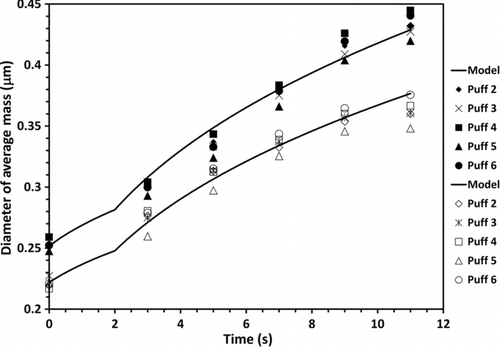
3. RESULTS
3.1. Experimental Aging Measurements
The individual points in indicate the measured diameters of average mass plotted versus aging time for smoke from two of the four smoking conditions studied, the medium ventilation cigarette at 35-mL puff volume (solid symbols) and the high ventilation cigarette smoked at 60-mL puff volume (open symbols). Both the DMA measurements and the coagulation simulations are reported as discrete size-bin populations that allow the calculation of the diameter of average mass. The diameter of average mass was used for comparison in order to better express in a single parameter the effects of both average size and breadth of distribution than would be the case for a number-based measure of size like geometric mean diameter. The diameter of average mass is also informative in that it directly reconciles total mass with total particle number. The zero aging time points are the measurements for fresh smoke exiting the cigarette and the subsequent aging times include the 2 s of dynamic aging as the smoke fills the syringe during the puffing plus the variable holding time after the puff. For example, the 3-s point is for smoke puffed into the syringe for 2 s and held statically in the syringe for 1 s. The highly variable lighting puff was not included in the analysis and puffs 2–6 have been plotted at each aging time. Each of the five points, one per puff, at each aging time, for each smoking condition, is the average of five replicate runs. The spread, with respect to the diameter of average mass, across puff number at each aging time for each smoking condition was random and on the order of the spread of replicate values for each puff, thus justifying the common treatment of all puffs at each aging time. The solid lines in are the best fits of the numerical model to the data and will be discussed below. The GSDs observed varied in a narrow range of 1.41–1.47.
The measured sizes and theoretical curves for the additional two smoking conditions studied, the low ventilation 60-mL puff and the medium ventilation 60-mL puff, fell between the two sets of data shown in and were very similar. The high ventilation cigarette initial particle size was similar to that for medium and low ventilation products but showed a slower rate of growth and a smaller final average size. The medium ventilation cigarette smoked at 35-mL puff volume had the largest initial particle diameter, but had a final size comparable with that for the medium and low ventilation cigarettes smoked at the 60 mL puff volume.
3.2. Fitting of Theoretical Model to Data
The solid lines in indicate the predicted diameters of average mass plotted versus aging time as determined by fitting the coagulation model to the experimental data given by the points in . The coagulation model predicts smoke size distributions at future times based on a specified initial size distribution. The initial size distribution was specified by relative size-bin populations, effectively average diameter and breadth of distribution, and total number concentration. The fitting procedure fixed the initial relative size-bin populations as those measured by the DMS500 and used the initial total number concentration as the single and only adjustable parameter. Varying the initial total number concentration for constant relative size-bin populations changed the shape and levels of the predicted curves as expected for a concentration-dependent coagulation rate. The best-fit curve corresponded to the value for initial total number concentration that minimized the differences between the measured and predicted average sizes. lists the best-fit initial total number concentrations and the corresponding mass concentrations for the four cigarette types studied.
TABLE 1 Best-fit initial total number concentrations with corresponding mass concentrations. Initial total number concentrations were those that resulted in the best overall fit of the numerical simulation model to the time-dependent experimental data using the measured initial average size and breath of distribution. Representative examples are shown in
4. DISCUSSION
4.1. Experimental Results and Numerical Simulation
indicates reasonable agreement between the measured particle size versus aging time data and the model simulations. The theoretical curves in show two distinct regions: the initial intrapuff period up to 2 s and the after puff period following 2-s aging time. The rate of diameter increase is lower during the intrapuff period, corresponding to mouth filling, than after due to the continuous supply of fresh, smaller particles to the coagulation smoke volume during the puffing. The more accurate “continuous feed” coagulation calculation gives a significantly smaller final size for the end of the puff time point than the simplified estimate made by allowing fresh smoke to statically coagulate for 2 s without an inflow of aerosol. For example, a fresh size of 0.22 μm diameter of average mass yields a 2 s size of 0.26 μm for continuous feed versus 0.30 μm for static aging.
It is important to emphasize that the dynamic aging of smoke in the mouth during puffing is significant and unavoidable during the normal smoking maneuver. Smokers do not inhale fresh smoke directly from cigarettes into the respiratory tract, and fresh smoke particle size, the most commonly reported measure, is not the size of smoke entering the trachea and should not be used in the modeling of respiratory particle deposition. Even if smoke is not held in the mouth after puffing, significant coagulation and particle growth takes place in the mouth during puffing, and the continuous feed of fresh smoke into the aging volume must be included to accurately model and describe the system.
The high dilution (1300–2350×) and reduced pressure (25 kPa) inside the DMS500 are conditions that create the opportunity for evaporation of volatile constituents from aerosol particles. Our comparisons of gravimetric filter total particulate mass to total particle mass reported by the DMS500 indicate that some evaporation is taking place, on the basis of the assumption that all the mass collected from fresh smoke on a filter, including a significant amount of water, is present in the aerosol as particulate matter. A detailed exploration of this mass accountability question for mainstream smoke measured by the DMS500 has been conducted and reported elsewhere (Alderman and Ingebrethsen Citation2011).
Both particle evaporation and electrometer counting efficiency are suspected as possible sources of inaccuracies in the measurement mainstream cigarette smoke that has a high number concentration and contains volatile particulate matter. Only initial number concentration was used as an adjustable parameter as allowing both initial particle size and initial number concentration to be adjustable parameters would have weakened the value of the theoretical analysis. We have determined that the possible range of pre-evaporation initial size distributions, as estimated on the basis of gravimetric filter collection, yields a unique best-fit initial number concentration that agrees with the time course of the size change as predicted by the model. On the contrary, taking the number concentrations reported directly by the DMS500 to be accurate and fitting the data by adjusting particle size does not predict particle size versus time dependencies in agreement with the observed time course of size growth based either on size as directly reported by the DMS500 or size adjusted for gravimetrically estimated evaporation. These observations formed the rationale for our use of initial number concentration as the adjustable parameter for fitting measurements to theory.
The possible influence of evaporation on the results of the current study was evaluated by examining coagulation rates based on particle size data adjusted for possible evaporation as estimated from gravimetric filter collection. Adjusted particle sizes were calculated by increasing the diameters of average mass reported by the DMS500 by 49%, this adjustment corresponded to a 30% mass accountability efficiency of the mobility measurements as compared with gravimetric filter collection. The adjustment of diameter of average mass was made by discretely increasing the mass concentration in each size bin by 49%. Fitting of the coagulation model to the adjusted data yielded the same number concentration and goodness of fit as with the unadjusted data suggesting that if there is a measured size inaccuracy due to evaporation, it is independent of particle size and not large enough to significantly change the coagulation rates. As noted above, calculations based on initial particle number concentrations directly reported by the DMS500 yielded poor agreement between the time course of the size change regardless of whether adjusted or unadjusted size date were used. The use of the directly measured sizes for the analysis is supported by the agreement of the time course of the directly measured sizes with coagulation theory, the success of a single initial number concentration in predicting the time course of the measured sizes, and the directional agreement of the fitted number concentrations with those expected from the cigarette yields (). For these reasons and given the relatively small diameter adjustments attributable to evaporation and the uncertainties in estimating evaporation factors for each cigarette type and smoking condition, only the directly measured values were used in the analysis.
The initial total number concentrations determined in the current study by fitting the measured size data to the coagulation model () are lower by a factor of from 2.1 to 3.6 than those reported elsewhere (Alderman and Ingebrethsen Citation2011) for the same cigarettes. The average sizes reported in the respective studies for the same cigarettes are in better agreement. Use of the initial total number concentrations from Alderman and Ingebrethsen in the coagulation model along with the measured relative size-bin populations yields poor agreement between the measurements and the model. Adjustments of measured number concentrations from Alderman and Ingebrethsen for possible biases, as discussed therein, also do not yield an acceptable fit with theory. A number of differences between the measurements of the two studies may be contributing factors to this discrepancy and are worth noting. The measurements in Alderman and Ingebrethsen were made with a similar Cambustion DMS500, but for unaged smoke only, introduced directly into the mobility analyzer with an automated puffing device. The current study measured smoke at somewhat different smoke concentration levels and over very different size ranges (much larger coagulated smoke versus only smaller, fresh smoke) than the earlier study. Given these observations, there is a possibility that these effects, or some yet to be identified experimental and/or instrumental biases, are contributing factors to the differences in number concentrations observed in the two studies.
4.2. Coagulation Simulations
Given the agreement discussed above between the coagulation simulation model and the results of the mainstream smoke aging experiments, some additional details of the simulation predictions for smoke aging in the mouth during smoking can be reliably explored. emphasizes the significant difference in size resulting from mainstream smoke aging with a continuous feed of fresh smoke versus static aging with no feed of smoke. Smoke size increases less for continuous feed aging than for static and increases for both cases by a larger proportion for more concentrated smoke. The coagulation during mouth filling is unavoidable in the normal smoking process. Smokers experience fresh smoke particle size only in the mouth at the start of the puff, and inhaled smoke is always larger in varying degrees than fresh smoke.
FIG. 6 Simulation results for the effect of mouth hold and posthold flushing time on number concentration.
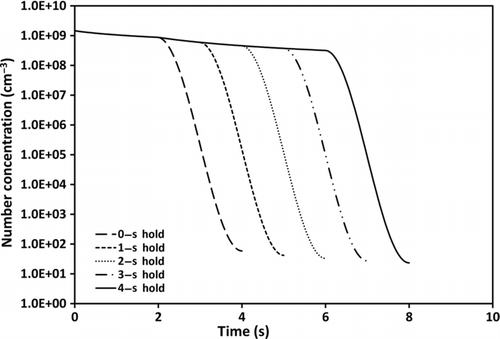
illustrates the changes in the size distributions of mainstream smoke from fresh to end-of-puff to that after 1-s hold in the mouth. The size distribution plotted for fresh smoke uses the measured size and the best-fit number concentration. The end-of-puff and 1-s aging distributions are those predicted by the coagulation calculations based on the given initial conditions. The data correspond to the medium ventilation cigarette data in . As discussed above, the total particulate mass calculated from these distributions is lower than that measured by gravimetric filter collection probably due to particle evaporation in the DMS500 and possible electrometer counting inaccuracies related to the high cigarette smoke number concentration. The number concentrations of particles greater than approximately 0.35 μm diameter increase as the smoke ages, while the concentrations of particles smaller than 0.35 μm decrease. The most significant change in number concentration is for the reduction in the numbers of the smallest particles as the smoke ages. Particles less than 0.10 μm have virtually been eliminated from the smoke after 1-s hold time.
and present simulation results for average size and number concentration, respectively, for mainstream smoke in the mouth as it is puffed, held for varying periods, and then flushed by inhalation air. In each case the initial, fresh smoke size is 0.22 μm and the smoke mass concentration is 16.7 μg/mL. During the 0- to 2-s period, fresh smoke is filling the expanding oral cavity. During the variable hold time, static coagulation proceeds at constant smoke volume with no inlet or exhaust flow. For the flush of smoke from the mouth, a 250 mL/s particle-free inhalation inlet flow is imposed along with a 250 mL/s exhaust flow of smoke assumed to be fully mixed with the inhaled air. Thus the time dependence of the size and number concentration of smoke that would feed from the mouth into the trachea during inhalation is predicted for realistic conditions of puffing, mouth holding, and inhalation.
FIG. 7 Simulation results for diameter of average mass versus smoke mass concentration for the end of 2-s puff time point and end of 1-s mouth hold time after puff.
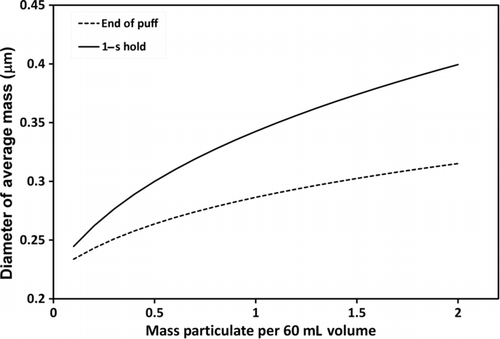
During the puffing, a lower rate of growth is predicted than for the subsequent fixed volume aging period, in agreement with the experimental results discussed above. The most salient feature of these simulations is the strong dependence of average particle diameter on mouth hold time illustrated in . While the increase of particle size in the mouth during puffing is unavoidable and presumably not highly variable among smokers, hold times and, by these predictions, inhaled particle size might be expected to show considerable variability corresponding to the large variability in human smoking patterns. The curves in indicate that some additional particle growth takes place in the mouth at the start of the inhalation as the smoke is being flushed from the mouth as shown by the difference between the average diameter at the end of the hold period and that for the plateau region.
Number concentration in the mouth decreases rapidly as inhalation proceeds and the smoke is swept from the mouth as indicated in . The information in and allows the predictions of properties of the smoke entering the trachea as a function of time and it should be emphasized that these curves are for conditions in the mouth only. The first parcels of smoke exiting the mouth are of sufficient concentration to exhibit additional growth by coagulation on the time scale of the inhalation depending on the levels of additional dilution that take place. Consequently, the quenching of coagulation growth in the mouth indicated by the plateau regions of should not be interpreted to imply that coagulation has been quenched in the entire respiratory tract for the remainder of the inhalation time frame.
shows the smoke average particle size predicted for the end of a 2-s puff and for an additional 1-s mouth hold as a function of mass concentration. The mass concentrations used in , 0.5 and 1.0 mg particulate matter per 60-mL puff volume, correspond to reasonable values produced by contemporary American cigarettes. These calculations are based on a constant fresh smoke average diameter and show that the mass concentration alone, apart from any variations in fresh smoke particle size, can be a significant determinant of inhaled smoke size distribution. Cigarette construction parameters (particularly filter efficiency and ventilation level) can influence mass concentration of smoke and, in turn, can have significant effects on the particle size resulting in the mouth during smoking.
5. CONCLUSIONS
The particle size of mainstream smoke exiting the mouth into the respiratory tract during inhalation is significantly larger than that of fresh smoke exiting the cigarette due to coagulation in the mouth. The nature of the puffing maneuver produces a complex coagulation environment with smaller size, fresh smoke continuously feeding into aging, growing smoke in the mouth. The net result of coagulation as the smoker's mouth fills with smoke is an average particle size larger than that of fresh smoke, but not as large as would be expected for coagulation of fresh smoke without a steady input of fresh smoke. The smallest particles, less than 0.10 μm diameter, are observed to be rapidly reduced in number in the mouth as the puff proceeds. A sectional-based simulation of Brownian coagulation under the varying conditions in the mouth during smoking is in agreement with controlled measurements of smoke aging with an apparatus that mimics the puffing maneuver. The simulations reveal that mouth hold time can have strong influence on inhaled smoke particle size, and that there is a strong dependence of inhaled particle size on fresh smoke mass concentration. These results should be useful in establishing realistic smoke particle size distributions of smoke exiting the mouth and entering the airways during smoking for use in the modeling of aerosol dynamics and particle deposition in the respiratory tract.
REFERENCES
- Alderman , S. L. and Ingebrethsen , B. J. 2011 . Characterization of Mainstream Cigarette Smoke Particle Size Distributions from Commercial Cigarettes Using a DMS500 Fast Particulate Spectrometer and Smoking Cycle Simulator . Aerosol Sci. Technol. , 45 : 1409 – 1421 .
- Baker , R. R. and Dixon , M. 2006 . The Retention of Tobacco Smoke Constituents in the Human Respiratory Tract . Inhal. Toxicol., , 18 : 255 – 294 .
- Bernstein , D. M. 2004 . A Review of the Influence of Particle Size, Puff Volume, and Inhalation Pattern on the Deposition of Cigarette Smoke Particles in the Respiratory Tract . Inhal. Toxicol. , 16 : 675 – 689 .
- Gelbard , F. and Seinfeld , J. H. 1980 . Simulation of Multicomponent Aerosol Dynamics . J. Colloid Interface Sci. , 78 : 485 – 501 .
- Gelbard , F. , Tambour , Y. and Seinfeld , J. H. 1979 . Sectional Representations for Simulating Aerosol Dynamics . J. Colloid Interface Sci. , 76 : 541 – 556 .
- Ingebrethsen , B. J. 2006 . Numerical Simulation of the Effects of Dilution Level, Depth of Inhalation, and Smoke Composition on Nicotine Vapor Deposition During Cigarette Smoking . Inhal. Toxicol , 18 : 1071 – 1076 .
- Lee , K. W. and Chen , H. 1984 . Coagulation Rate of Polydisperse Particles . Aerosol Sci. Tech. , 3 : 327 – 334 .
- Robinson , R. J. and Yu , C. P. 1999 . Coagulation of Cigarette Smoke Particles . J. Aerosol Sci. , 30 : 533 – 548 .
- Robinson , R. J. and Yu , C. P. 2001 . Deposition of Cigarette Smoke Particles in the Human Respiratory Tract . Aerosol Sci. Tech. , 34 : 202 – 215 .
